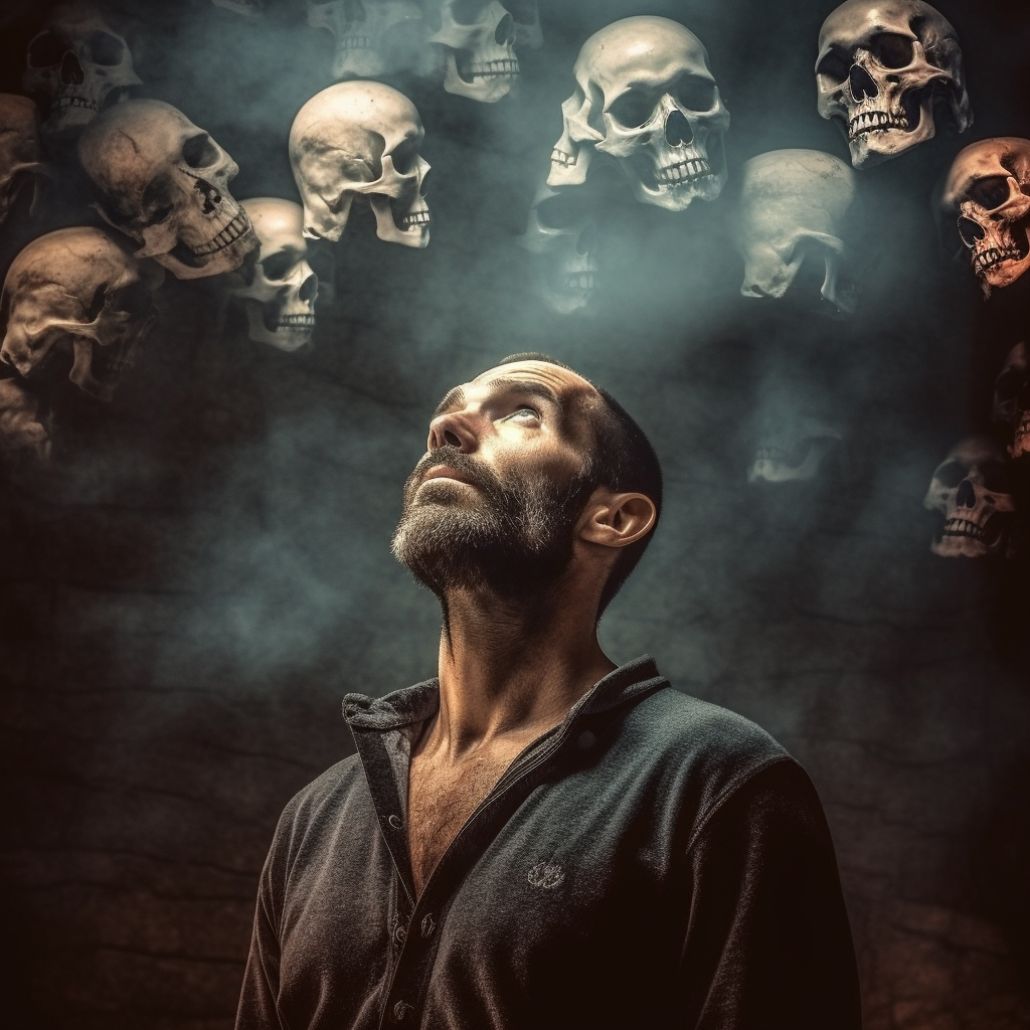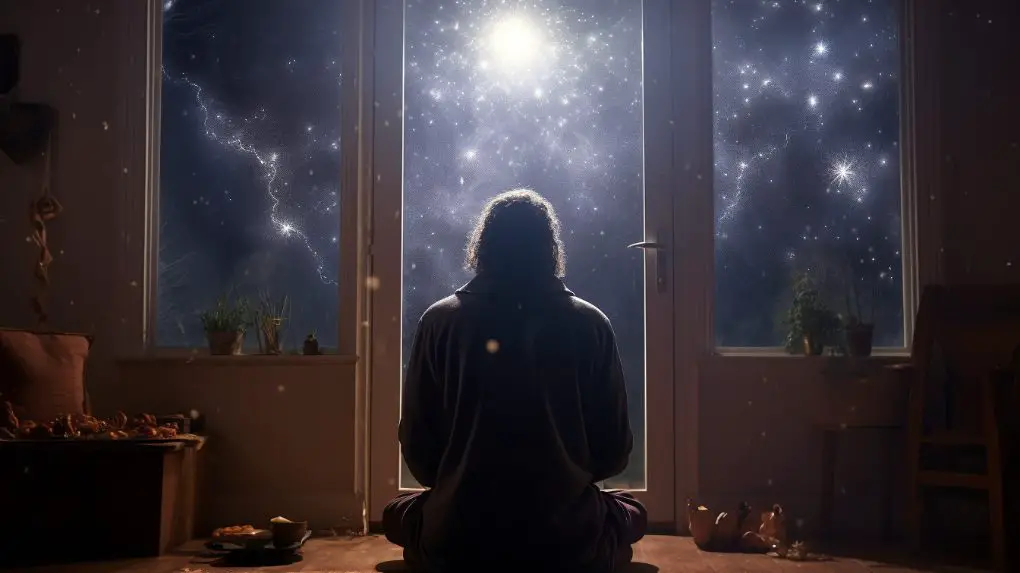In a bustling Hebrew school nestled in the heart of a vibrant Jewish community, I remember being a curious child grappling with the profound question that has intrigued human beings since time immemorial – what happens after we die?
As I embarked on a personal and spiritual journey, delving deep into the vast sea of Jewish thought and tradition, I realized that the answer to this question is as rich and varied as the Jewish people themselves.
Personal Connection to the Topic
Growing up in a very assimilated family, my initial understanding of life, death, and what lay beyond was perhaps a blend of Western world influences and the traditional Judaism that fluttered in the background of our lives.
As I grew older, the desire to connect more deeply with my roots led me to explore the depth of Jewish philosophy, historical perspectives, and the perspectives held within the diverse Jewish community about the afterlife. This journey, akin to a near-death experience, allowed me to unravel the complexities of Jewish beliefs surrounding the afterlife, giving a glimpse into the eternal life that Judaism believes in.
The Foundations of Jewish Beliefs on Afterlife
Jewish beliefs regarding the afterlife are deeply rooted in a rich tapestry of history, scriptures, and traditions. Throughout Jewish history, these beliefs have evolved, presenting a multifaceted view on what happens after a person dies.
The Hebrew Bible and Its Insights
Central to understanding the concept of the afterlife in Jewish tradition is the Hebrew Bible, or what many refer to as the Old Testament. The scriptures often depict the afterlife as a shadowy place known as Sheol. Here, it is believed that the dead reside, irrespective of their deeds during their lifetime. The concept of a morally neutral afterlife can be somewhat perplexing to modern Jews, as it contrasts sharply with the vibrant life emphasized in Jewish teachings.
During the early Biblical period, the emphasis was more on the present world, urging individuals to lead a life of righteousness and good deeds, to foster a prosperous and harmonious society. As we traverse further into the scriptures, particularly by the time of the writings in the second century BCE, we find a shift in this perspective, hinting at a more complex view of the afterlife where the righteous are rewarded and the wicked face everlasting abhorrence.
Development in the Second Century BCE
Around the second century BCE, a significant transformation in Jewish thought was occurring. Jewish philosophers and scholars began exploring the concept of everlasting life, where the soul continues its journey even after the physical body succumbs to death. The writings from this period, rich with metaphysical contemplations, began introducing the idea of bodily resurrection in the messianic age, a concept deeply ingrained in orthodox Judaism.
This phase saw the burgeoning of an enriched rabbinic tradition, fostering a more nuanced understanding of life, death, and what lies beyond. The seeds of beliefs in a structured afterlife were sown, paving the way for a plethora of interpretations and viewpoints in the centuries to follow, fostering a rich narrative that resonated deeply with the Jewish people.
The Concept of Eternal Life in Jewish Tradition
Jewish tradition harbors a rich and intricate understanding of eternal life. As I deepened my exploration into the myriad perspectives within my community and the ancient texts that have guided us for centuries, I found myself drawn into a mesmerizing world of philosophy and faith that transcends the boundaries of life as we know it.
The Definitions in Jewish Philosophers
Diving deeper into my research, I encountered the profound insights of Jewish philosophers who grappled with the notion of eternal life throughout the middle ages and beyond. Figures like Maimonides, a luminary in medieval Jewish philosophy, offered thought-provoking interpretations of the scriptures, addressing the dual nature of human beings – comprising both physical bodies and a soul.
According to many Jewish philosophers, the soul exists eternally and embarks on a journey beyond the physical world upon death. They envisioned a kind of spiritual evolution where the soul, free from the constraints of the physical body, could attain a higher level of understanding and closeness to God. This intricate dance between the corporeal and the spiritual forms the core of many debates and discussions within the sphere of Jewish thought on eternal life.
Perspectives from Medieval Jewish Philosophy
Medieval Jewish philosophy, a golden era of Jewish thought, presents a captivating blend of rationalism and mysticism. Scholars from this period, deeply influenced by the philosophical currents of their time, sought to reconcile faith and reason, delving deep into the mysteries of life and death.
This era saw a flourishing of ideas concerning the nature of the afterlife, with concepts such as Gan Eden (the Garden of Eden) and Gehinnom (a place of purification, sometimes equated with Hell) becoming more defined. Gan Eden, described in Rabbinic literature as a paradise for the righteous, represented the ultimate reward for individuals who led a life in accordance with God’s commandments.
Gehinnom, on the other hand, represented a place where the wicked soul undergoes a process of purification before being able to enter Gan Eden. This period of Jewish history enriched the already complex narrative concerning the afterlife, introducing elements of moral accountability and justice that resonate with modern Jewish thought.
As I delved into these philosophical treasures, I found myself immersed in a sea of wisdom and spiritual insights that seemed to echo the questions and contemplations I had nurtured since my days in Hebrew school. A deep sense of connection to the generations that came before me blossomed, offering both comfort and a sense of responsibility to continue this age-old quest for understanding.
Related: Exploring the Roots of Past Life Astrology
The Different Layers of the Jewish Afterlife
As I ventured further into the exploration of Jewish beliefs surrounding the afterlife, I was beckoned into a realm where heavenly gardens awaited the righteous and purification processes promised growth and refinement for the souls embarking on their journey to the next world. This facet of Jewish life seemed to resonate profoundly with the natural cycles of growth, decay, and renewal that govern our physical world.
Gan Eden: The Paradise
The concept of Gan Eden, or the Garden of Eden, occupies a central place in the Jewish views of the afterlife. Referred to as a paradise where the righteous are rewarded with a place in the “World to Come,” or Olam Ha Ba, it is described as a heavenly abode that transcends the limitations of our physical existence.
Growing up, I often heard tales of this wondrous place, where souls rejoiced in the presence of God, basking in the eternal light of wisdom and love. This narrative of Gan Eden seemed to paint a vivid picture of a gated community, where the barriers of mortality fell away, leaving only the purest essence of the human spirit to flourish.
As an adult, exploring these concepts felt akin to revisiting a cherished place from childhood, yet with a deeper understanding and appreciation for the complexities of life and death. Through the lens of Jewish tradition, Gan Eden unfolded as a symbol of hope and a testament to the everlasting life promised to those who walked the path of righteousness.
Gehinnom: The Place of Purification
Contrasting with the blissful narratives of Gan Eden are the teachings surrounding Gehinnom. In my journey, grappling with the concept of Gehinnom became a potent reminder of the dual nature of existence. Here, it is believed, the soul undergoes a process of purification, shedding the layers of negativity and moral lapses accumulated during a lifetime.
In the community where I grew up, Gehinnom was often discussed with a sense of solemnity, a reminder of the consequences that awaited those who strayed from the path of good deeds. As I immersed myself in the texts describing this place, I encountered a more nuanced narrative. Gehinnom appeared not as a place of punishment, but as a realm of growth, where the soul had the opportunity to cleanse itself, to prepare for a return to the source of all life, God.
Through the years, as I attended various gatherings and discussions within the Jewish community, I noticed how these narratives fostered a deep sense of accountability and moral responsibility, encouraging individuals to strive for a life of virtue and spiritual fulfillment.
The Importance of the Messianic Era
As I journeyed deeper, beyond the realms of Gan Eden and Gehinnom, I encountered the vibrant teachings surrounding the Messianic Era – a period anticipated in Jewish tradition as a time of universal peace and divine presence on earth. These doctrines, rooted deeply in Jewish scriptures, opened up avenues to contemplate life and the afterlife in a harmonious future guided by a messianic figure.
The Concept of Olam Ha Ba
In Jewish tradition, the term “Olam Ha Ba” often refers to the world to come, a future reality promising peace, righteousness, and the embodiment of God’s kingdom on earth. My earlier years in Hebrew school seemed to echo in my memory as I revisited teachings about a time where the righteous live forever in a world renewed.
In this period, it is believed, those who have passed away will be resurrected, experiencing life in a transformed world where good triumphs over evil. This belief in a resurrected body and a renewed world holds a central place in Jewish thought, providing a beacon of hope and a vision of a future where all the struggles and inequities of the present world are resolved.
As I navigated through the layers of rabbinic literature and community discussions, I found that the belief in Olam Ha Ba served as a powerful motivator, encouraging individuals to cultivate virtues and live a life aligned with the divine principles of justice and compassion.
The Role of Righteous People in the Messianic Age
Delving into the concept of the Messianic Age, I came across the vital role that righteous people, or the ‘tzaddikim,’ play in this envisioned future. In the Jewish community, the figure of the tzaddik serves as a moral compass, exemplifying a life lived in close communion with God.
In the messianic era, these individuals are seen as beacons of light, guiding the rest of humanity towards a life of harmony and divine connection. As someone who has witnessed the profound impact of such figures in the Jewish community, the idea resonated deeply with me. It fostered a sense of responsibility, encouraging individuals to strive towards righteousness, not just for personal salvation, but for the betterment of the entire world.
As I pondered these teachings, I could not help but feel a sense of unity with the generations who had held onto this hope, nurturing a vision of a world where love, peace, and justice prevailed, transcending the barriers of life and death.
Also read Past Life Regression for Kids: How to Help Them Explore Their Memories
Understanding the Spectrum of Jewish Beliefs about the Afterlife
As my journey through the vibrant tapestry of Jewish thought continued, I was reminded of the remarkable diversity in interpretations and beliefs surrounding the afterlife. From Orthodox Judaism to Reconstructionist Judaism, each strand offers a unique perspective, adding depth and complexity to the Jewish understanding of life, death, and what lies beyond.
Orthodox Judaism: Adherence to Tradition
Orthodox Judaism, deeply rooted in tradition and the meticulous study of Hebrew scriptures, offers a perspective on the afterlife that emphasizes the resurrection of the dead and the world to come. As I interacted with members of the Orthodox Jewish community, I noticed a deep reverence for the traditions and the teachings contained within the Hebrew Bible.
In this tradition, the notion of the soul returning to God and the eventual bodily resurrection are central themes. Growing up in a very assimilated family, the encounters with Orthodox Jews offered me glimpses into a world where the past resonates vibrantly in the present, creating a continuous thread that weaves through generations, connecting the Jewish people in a profound and enduring bond.
Reconstructionist Judaism: A Modern Interpretation
On the other hand, Reconstructionist Judaism, a relatively modern movement, approaches the concept of the afterlife with a more metaphorical lens. While navigating through various Jewish communities, I found that Reconstructionist Judaism seemed to resonate with many modern Jews, offering a framework that melded tradition with contemporary insights.
In my conversations with fellow community members, I often found that this branch of Judaism encourages individuals to explore the afterlife concepts as symbolic narratives, providing moral and philosophical guidance rather than a literal account of what happens after death. This approach, grounding spirituality in the context of the modern world, offers a refreshing perspective that invites individuals to craft a personal understanding of the afterlife, in harmony with the broader teachings of Judaism.
During my explorations, the richness of perspectives within the Jewish community became increasingly apparent, weaving a multi-faceted tapestry that honored both the depths of tradition and the evolving insights of modern Jewish thought.
Delving into Jewish Mysticism and the Afterlife
My journey took a deeper turn as I ventured into the realms of Jewish mysticism, a facet of Judaism that offers a rich and profound exploration of the afterlife. This ancient stream of Jewish thought encompasses a broad spectrum of beliefs, from the journey of the soul to the intricate layers of heaven and the mysteries that lie beyond the grasp of the human intellect.
Kabbalistic Views on the Soul’s Journey
In the world of Jewish mysticism, particularly in Kabbalistic traditions, the journey of the soul occupies a central role. I remember being mesmerized by tales of ascensions, divine chariots, and heavenly palaces during my deeper explorations. The Kabbalists, steeped in ancient wisdom, envision the soul embarking on a complex journey, traversing various realms in its quest for reunification with the Divine.
Drawing upon age-old traditions and mystical insights, the Kabbalists paint a vivid picture of the afterlife, where the soul undergoes transformations and purifications, guided by the celestial forces that govern the universe. As someone who has experienced the deep reverberations of these teachings, I found myself immersed in a cosmic dance, where life and death became intertwined in a mystical ballet of eternal life.
Hasidic Teachings on Life and the World to Come
The Hasidic movement, which emerged in the 18th century, brought a refreshing wave of spirituality and joyous devotion to the Jewish community. As I ventured into the teachings of Hasidic masters, I encountered narratives filled with joy, love, and a deep connection to God.
Hasidic teachings emphasize the intrinsic goodness of human beings and encourage a life filled with joyous service to the Divine. In their view, the afterlife becomes a grand celebration, a banquet hall where souls reunite in an eternal dance of love and devotion. This notion of the afterlife as a place of joyous reunion and divine ecstasy resonated deeply with me, providing a refreshing perspective on the journey that awaits us beyond the physical realm.
As I navigated through the intricate pathways of Jewish mysticism, I found myself entranced by the depth and beauty of these teachings, finding echoes of these ancient narratives in the pulse of the modern Jewish community, ever vibrant and filled with the longing for a deeper connection to the Divine.
Philosophical Perspectives on the Afterlife
Navigating deeper into the river of Jewish thought, I found myself encountering the profound philosophical discussions that have shaped Jewish beliefs about the afterlife over the centuries. From the musings of ancient scholars to the inquiries of medieval Jewish philosophy, the endeavor to understand life, death, and the beyond has been a vibrant part of Jewish intellectual tradition.
Medieval Jewish Philosophy on Eternal Life
During the period of the Middle Ages, Jewish philosophers engaged in deep intellectual explorations concerning the nature of the soul and the afterlife. Figures like Maimonides became pillars in this era, their works offering intricate insights into the complexities of life and the world beyond.
As I delved into the writings from this period, I felt as though I was engaging in a time-honored dialogue, one that spanned centuries and cultures. The medieval philosophers proposed ideas about the immortal soul, the nature of God, and the quest for moral excellence, weaving a rich tapestry of thought that has profoundly influenced Jewish beliefs about eternal life.
In my own journey, grappling with these philosophical concepts became a bridge connecting me with the intellectual giants of the past, fostering a deeper understanding of the complex narratives surrounding life, death, and what lies beyond.
Modern Jewish Thought on Life After Death
In contrast, modern Jewish thought has brought forth a diverse array of perspectives on the afterlife. Figures such as Martin Buber and Abraham Joshua Heschel have contributed to a rich discourse that seeks to reconcile ancient wisdom with the challenges and insights of the contemporary world.
As I engaged with the modern philosophical discourse, I found a vibrant community of thinkers exploring the mysteries of existence with a fresh lens, integrating the wisdom of the ages with the evolving understanding of the human condition. This interaction with modern Jewish philosophy became a beacon of light, guiding me towards a nuanced appreciation of the rich and diverse landscape of Jewish thought on the afterlife.
In this journey, I felt a deepening connection to a tradition that valued intellectual rigor and spiritual exploration, forming a living bridge between the ancient wisdom of the scriptures and the pulsating heartbeat of the modern Jewish community.
Don't miss Where Do We Go After We Die? Theories on the Afterlife and Soul
Jewish Mourning Traditions and the Afterlife
Jewish traditions harbor a profound respect for the sanctity of life and a deep acknowledgment of the mystery of death. As my journey continued, I found myself immersed in the rich tapestry of Jewish mourning traditions, where the realms of the living and the departed are interwoven in a fabric of memory, prayer, and community.
Mourners Kaddish: A Prayer of Remembrance
During my own experiences with loss, I discovered the transformative power of the Mourner’s Kaddish, a prayer that occupies a central place in Jewish mourning traditions. This ancient prayer, uttered in the congregation of the Jewish community, serves as a bridge connecting the living with the souls who have journeyed to the next world.
As I joined in the communal recitation of the Kaddish, I felt the presence of generations past, a tangible link that united the Jewish people in a circle of memory and hope. The Kaddish, with its rhythmic cadences, became a vessel for grief, love, and the everlasting bond that transcends the barriers of life and death.
Unveiling of the Tombstone: A Ritual of Connection
The ritual of unveiling the tombstone, a significant event in the Jewish mourning process, served as a poignant reminder of the deep connections that bind the Jewish community. In my own experiences, I witnessed the fusion of sorrow and hope as families came together to honor the memory of their loved ones.
This ceremony, rich in symbolism, became a canvas where the stories of the departed were etched in stone, a permanent testament to the lives lived and the legacy left behind. The unveiling became a gateway, a moment where the veil between the worlds seemed to thin, offering a glimpse into the eternity that awaited beyond the confines of the physical world.
As I navigated through the labyrinth of Jewish mourning traditions, I found myself enveloped in a community that embraced both the joy and the sorrow of existence, weaving a narrative that honored the mystery of life and the journey that awaited in the world beyond.
Near Death Experience: A Personal Journey
In my journey, I ventured into the intriguing territory of near-death experiences — a facet that profoundly resonated with me, as I myself have brushed with the mysteries that dwell at the borders of life and death. This voyage into the realm of personal experiences and narratives added an intimate layer to the rich tapestry of Jewish beliefs about the afterlife.
A Glimpse Beyond: My Personal Encounter
Embarking on a journey that felt as ancient as time itself, I found myself exploring the various narratives surrounding near-death experiences within the Jewish tradition. My personal journey in this regard was nothing short of transformative. A series of events led me to experience a phenomenon where the boundaries between this world and the next seemed to blur, providing a glimpse into the mysteries of the afterlife.
In this deeply personal encounter, I experienced sensations that echoed the descriptions found in various Jewish texts, a world bathed in a light that seemed to emanate love and understanding, a place where the boundaries that separate us in the physical world seemed to dissolve, fostering a profound sense of unity and interconnectedness.
Drawing Parallels with Traditional Narratives
As I delved deeper into this realm, I found that my experiences resonated with many narratives found within the Jewish tradition. These accounts, some steeped in ancient scriptures, others echoing through the words of contemporary individuals, painted a vivid picture of a world beyond, a place where the soul continues its journey, unfettered by the limitations of the physical body.
Drawing parallels with these traditional narratives allowed me to forge a deeper connection with the collective experiences of others who have ventured into this mysterious domain. These narratives, rich in imagery and metaphor, provided a comforting framework, allowing for a deeper exploration into the nature of life, death, and the intricate dance that weaves them together in the grand tapestry of existence.
Through this journey, I discovered that the realm of near-death experiences held a mirror to the deep-seated beliefs and narratives that have shaped Jewish thought throughout the ages, offering a personal testament to the enduring quest for understanding and connection in the face of life’s greatest mystery.
Related Article Meditation for Astral Projection – Deepening Your Connection With The Universe
Conclusion: The Mosaic of Jewish Beliefs on the Afterlife
A Journey Through Time and Tradition
This journey has been akin to wandering through a living mosaic, where each fragment, whether it be a scriptural text or a personal narrative, contributes to a larger, vibrant picture that speaks of the human endeavor to grasp the infinite. The Jewish tradition, with its deep roots in history and an ever-evolving understanding of the world, offers a rich canvas where questions of life, death, and the afterlife find varied and profound expressions.
Through the labyrinthine pathways of Jewish history, we encounter a tradition that nurtures a deep respect for the sanctity of life, a reverence for the mysteries of death, and a hopeful gaze towards the possibilities of the world to come. It is a journey that has fostered a community united in prayer, memory, and the ceaseless quest for knowledge and understanding.
As we stand at the crossroads of time, we find that the Jewish dialogue on the afterlife is far from over. It continues to evolve, embracing new insights and perspectives, nurturing a vibrant tradition that seeks to understand the complexities of existence in a universe that is as mysterious as it is beautiful.
Looking ahead, we venture forth with a spirit of open inquiry and reverence, ready to explore the new horizons that await us in the eternal dance of life and death. It is a journey that promises not only understanding but also a deep, transformative connection to the tapestry of life itself, woven through time and echoing into eternity.



